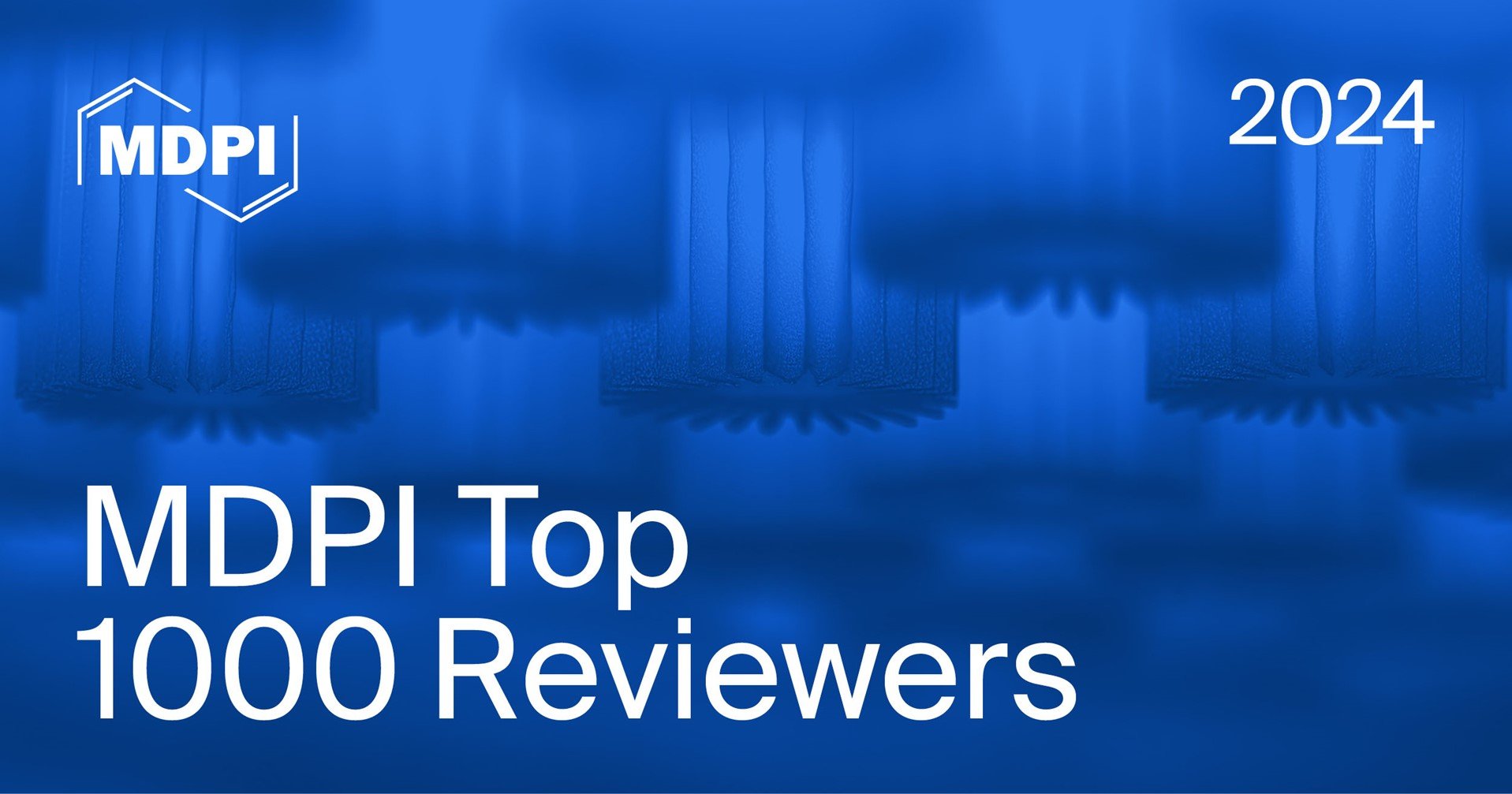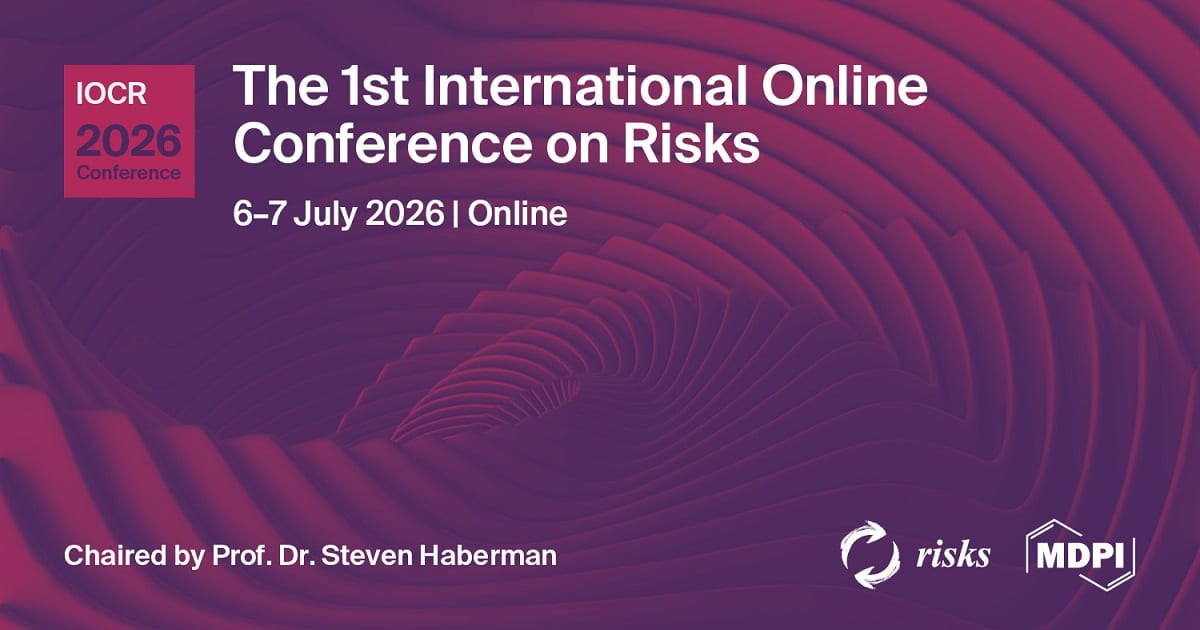Journal Description
Journal of Risk and Financial Management
Journal of Risk and Financial Management
is an international, peer-reviewed, open access journal on risk and financial management, published monthly online by MDPI.
- Open Access— free for readers, with article processing charges (APC) paid by authors or their institutions.
- High Visibility: indexed within Scopus, EconBiz, EconLit, RePEc, and other databases.
- Journal Rank: CiteScore - Q1 (Business, Management and Accounting (miscellaneous))
- Rapid Publication: manuscripts are peer-reviewed and a first decision is provided to authors approximately 20.5 days after submission; acceptance to publication is undertaken in 4.6 days (median values for papers published in this journal in the first half of 2025).
- Recognition of Reviewers: reviewers who provide timely, thorough peer-review reports receive vouchers entitling them to a discount on the APC of their next publication in any MDPI journal, in appreciation of the work done.
Latest Articles
Systematic Review of Emerging Trends and Developments in Sustainability Accounting
J. Risk Financial Manag. 2025, 18(11), 621; https://doi.org/10.3390/jrfm18110621 - 6 Nov 2025
Abstract
This systematic review examines how sustainability is utilized by government institutions in reporting and tracking social and environmental impacts. As a result of the Prisma 2020 guidelines, we examined 84 papers published between 2009 and December 2024 and identified four key themes: sustainability
[...] Read more.
This systematic review examines how sustainability is utilized by government institutions in reporting and tracking social and environmental impacts. As a result of the Prisma 2020 guidelines, we examined 84 papers published between 2009 and December 2024 and identified four key themes: sustainability reporting procedures, social re-management, incorporating sustainability into decision-making, and stakeholder engagement. The findings suggest significant reporting gaps in the public sector and the need for better systems and practices. This study emphasizes both theoretical and practical consequences, and it recommends strengthening transparency and responsibility, evolving the role of sustainability accounting in public institutions. It also identifies critical areas to address in future research, ensuring the alignment of public sector objectives. This study—by including difficulties in reporting and visualizing how accounting practices can be developed toward sustainability—contributes findings on sustainability can be used to improve governance and accountability in the public sector. However, a limitation is that this review only relies on the Web of Science (WoS) database, which can affect the comprehensiveness of our findings. Potential omissions of relevant databases, such as Scopus or Google Scholar, should be noted, and future research could be enhanced with the addition of a wider range of resources for more comprehensive analysis.
Full article
(This article belongs to the Special Issue Future of Accounting and Finance: Trends and Technologies Shaping the Industry)
►
Show Figures
Open AccessArticle
The Overnight Jump: Disentangling Microstructural and Informational Volatility in TOCOM Rubber Futures
by
Chu Chu, Salang Musikasuwan and Rattikan Saelim
J. Risk Financial Manag. 2025, 18(11), 620; https://doi.org/10.3390/jrfm18110620 (registering DOI) - 6 Nov 2025
Abstract
The systematic failure of standard Value-at-Risk (VaR) models for the Tokyo Commodity Exchange (TOCOM) rubber futures contract poses significant challenges for risk management. This study addresses the issue by examining the market’s split trading sessions, which induce distinct overnight and intraday volatility regimes.
[...] Read more.
The systematic failure of standard Value-at-Risk (VaR) models for the Tokyo Commodity Exchange (TOCOM) rubber futures contract poses significant challenges for risk management. This study addresses the issue by examining the market’s split trading sessions, which induce distinct overnight and intraday volatility regimes. We decompose daily returns into these two components and apply tailored Generalized Autoregressive Conditional Heteroskedasticity (GARCH) family models. Our empirical results, strengthened by extensive robustness checks using EGARCH, IGARCH, and GJR-GARCH specifications, reveal that intraday volatility is persistent and influenced by leverage effects, whereas overnight volatility behaves as a jump-driven process unaccounted for by conventional models. Comprehensive VaR backtesting confirms that while traditional models accurately capture intraday risk, all standard daily models—including asymmetric variants—systematically and severely underestimate overnight risk. These findings demonstrate that aggregating returns into a single daily series conflates different volatility dynamics, leading to model failures. We propose a two-tiered risk management framework that separately applies conventional models to intraday risk and jump-aware measures for overnight risk. This approach aligns risk assessment with underlying market microstructure, improving model validity and capital adequacy for TOCOM rubber futures.
Full article
(This article belongs to the Section Financial Markets)
►▼
Show Figures

Figure 1
Open AccessArticle
R&D Investment, Skill-Based Wage Gap, and Firm Innovation Performance: Evidence from Chinese Listed Companies
by
He Tong, Saizal Pinjaman and Debbra Toria Nipo
J. Risk Financial Manag. 2025, 18(11), 619; https://doi.org/10.3390/jrfm18110619 - 5 Nov 2025
Abstract
Against China’s innovation-driven strategy, this study explores the impact of R&D investment on firm innovation performance and the mediating role of the wage gap between high- and low-skilled labor (HLWG) using data from Chinese A-share non-financial listed firms spanning 2010–2022. Employing static panel
[...] Read more.
Against China’s innovation-driven strategy, this study explores the impact of R&D investment on firm innovation performance and the mediating role of the wage gap between high- and low-skilled labor (HLWG) using data from Chinese A-share non-financial listed firms spanning 2010–2022. Employing static panel regression, Bootstrap test, and instrumental variables (R&D investment deduction, college enrollment expansion), the study finds three key results. First, R&D investment positively affects both firm innovation performance and HLWG. Second, HLWG exerts a positive impact on firm innovation performance. Third, HLWG plays a partial mediating role in the relationship between R&D investment and firm innovation performance. Robustness tests and instrumental variable regression confirm the stability of these conclusions. This finding enriches the theoretical understanding of the R&D-innovation transmission mechanism, offers insights into enterprises to coordinate R&D investment and wage structure optimization, and provides policy references for refining innovation incentives and labor market policies.
Full article
(This article belongs to the Section Business and Entrepreneurship)
►▼
Show Figures

Figure 1
Open AccessArticle
Tax Policy and SME Compliance in South Africa: Insight from Tax Practitioners
by
Lungisani Lucky Buthelezi and Masibulele Phesa
J. Risk Financial Manag. 2025, 18(11), 618; https://doi.org/10.3390/jrfm18110618 - 5 Nov 2025
Abstract
Tax practitioners (such as accountants and bookkeepers) are important enablers of tax compliance. Taxpayers, particularly small businesses, look to tax practitioners for expert advice because of increasingly complex tax legislation. This study’s purpose was to examine tax practitioners’ perspectives on tax policy and
[...] Read more.
Tax practitioners (such as accountants and bookkeepers) are important enablers of tax compliance. Taxpayers, particularly small businesses, look to tax practitioners for expert advice because of increasingly complex tax legislation. This study’s purpose was to examine tax practitioners’ perspectives on tax policy and SME compliance in South Africa. This study looks at the perspective of tax practitioners to extend information on tax policy and its effect on the tax compliance of SMEs. A total of 90% of companies in South Africa are classified as SMEs, which account for more than 80% of employment in the economy. Despite the importance of the SME sector in job creation, tax policies and the costs associated with them are major issues affecting the overall regulatory environment and they are identified as a major threat to SMEs’ growth. This study seeks to close this gap by examining practitioners’ perspectives on tax policy and SME compliance in South Africa. This study adopted a quantitative approach using a self-administered questionnaire which was emailed to a sample of 255 tax practitioners by using a link through QuestionPro, and this study applied descriptive statistics in analysing data. This study indicated that tax practitioners have sufficient experience and qualifications to prepare and handle tax matters for SMEs. This study demonstrated that SMEs register for taxes, file annual returns, and pay tax liability within the period stipulated by tax law. It further indicated that being tax-compliant has certain benefits for SMEs. This research is intended to assist tax authorities and the government in better creating measures to address the problem of tax compliance among SMEs in South Africa. This article adds to the body of knowledge because it uses the opinion of tax practitioners to extend debate on tax policy in tax compliance and its effect on the functioning of SMEs.
Full article
(This article belongs to the Special Issue Synergizing Accounting Practices and Tax Governance)
Open AccessArticle
Impact of Sustainability Reporting on Financial Performance: A Multigroup Analysis of Jordanian Firms in High-Pollution and Low-Pollution Industries
by
Almothanna Abu-Allan
J. Risk Financial Manag. 2025, 18(11), 617; https://doi.org/10.3390/jrfm18110617 - 4 Nov 2025
Abstract
As global emphasis on environmental, social, and governance practices intensifies, sustainability reporting emerges as a critical tool for corporate transparency and accountability. The study aims to assess the impact of sustainability reporting on the financial performance of listed companies in Jordan. Using a
[...] Read more.
As global emphasis on environmental, social, and governance practices intensifies, sustainability reporting emerges as a critical tool for corporate transparency and accountability. The study aims to assess the impact of sustainability reporting on the financial performance of listed companies in Jordan. Using a quantitative approach, a total of 588 individuals were surveyed from low-pollution and high-pollution industries using purposive sampling techniques. Partial Least Square Structural Equation Modeling (PLS-SEM) was used to conduct analysis of the data with the aid of SMART PLS4 software. The study finds that the impact of sustainability disclosures on firms’ financial performance in Jordan differs significantly by both the type of disclosure and the pollution intensity of the industry the firms belong to. Environmental impact reporting (EIR) and social impact reporting (SIR) both have positive and significant effects on financial performance, especially in low-pollution industries, probably because of a perceived proactive and authentic integration of sustainability practices. However, governance impact reporting (GIR) shows a negative relationship with financial performance, which implies that such disclosures may be perceived as compliance-driven or not authentic. These findings indicate that the context of the sustainability reporting strategy is an important element in determining its effect on financial performance. The multigroup analysis (MGA) results help us to gain a better understanding of how different sectors leverage financial value from disclosing their sustainability activities. The study confirms that sustainability disclosure is not just a compliance requirement, but an instrument that can help firms improve their financial performance. Finally, we recommend that future research should investigate deeper psychological and social mechanisms likely to influence stakeholder responses across different sectors and countries within the region.
Full article
(This article belongs to the Section Business and Entrepreneurship)
►▼
Show Figures
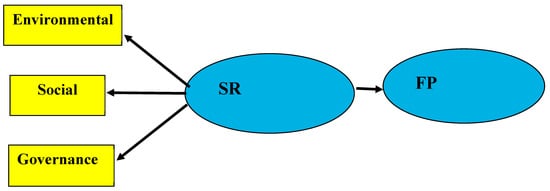
Figure 1
Open AccessArticle
Sustainable Environmental Governance and Corporate Environmental Performance: Empirical Evidence from Saudi Companies
by
Jihene C. Soussi, Khaled S. Aljaaidi and Neef F. Alwadani
J. Risk Financial Manag. 2025, 18(11), 616; https://doi.org/10.3390/jrfm18110616 - 4 Nov 2025
Abstract
This study investigates the internal governance mechanisms of sustainability and their influence on corporate environmental performance (CEP) from 2014 to 2021 in Saudi Arabia. The analysis centers on three primary mechanisms: the presence of a sustainability committee, issuance of sustainability reports, and external
[...] Read more.
This study investigates the internal governance mechanisms of sustainability and their influence on corporate environmental performance (CEP) from 2014 to 2021 in Saudi Arabia. The analysis centers on three primary mechanisms: the presence of a sustainability committee, issuance of sustainability reports, and external assurance of these reports. Utilizing a sample of 188 firm-year observations from publicly listed companies, we evaluate each mechanism and their combined effect as predictors of CEP through ordinary least squares (OLS) regression analysis. We constructed a composite index of sustainability governance practices to assess the overall governance strength of the firm, referred to as the sustainability index. Our findings indicate that, while sustainability external assurance is positively associated with CEP, it is statistically insignificant. By contrast, the positive correlations of sustainability committees and sustainability reports with CEP were significant. The overall sustainable mechanisms’ composite index in the regression positively influences corporate environmental performance. This suggests that the composite sustainability index is more effective than individual sustainability mechanisms because of its complementary functions. This study aims to advance theories related to emerging markets in which institutional arrangements and stakeholder demands differ from those in developed countries. These results emphasize on the importance of corporate boards and policymakers in establishing dedicated sustainability committees, enhancing reporting quality, and integrating various governance systems to improve environmental performance which, in turn, promote responsible corporate behavior and ensure accountability towards environmental protection and sustainable development. This aligns with Saudi Arabia’s Vision 2030 and the Sustainable Development Goals, specifically Goals 12 and 13.
Full article
(This article belongs to the Special Issue Corporate Finance and ESG: Shaping the Future of Sustainable Business)
Open AccessArticle
Modular Architectures for Interpretable Credit Scoring for Heterogeneous Borrower Data
by
Ayaz A. Sunagatullin and Mohammad Reza Bahrami
J. Risk Financial Manag. 2025, 18(11), 615; https://doi.org/10.3390/jrfm18110615 - 4 Nov 2025
Abstract
Modern credit scoring systems must operate under increasingly complex borrower data conditions, characterized by structural heterogeneity and regulatory demands for transparency. This study proposes a modular modeling framework that addresses both interpretability and data incompleteness in credit risk prediction. By leveraging Weight of
[...] Read more.
Modern credit scoring systems must operate under increasingly complex borrower data conditions, characterized by structural heterogeneity and regulatory demands for transparency. This study proposes a modular modeling framework that addresses both interpretability and data incompleteness in credit risk prediction. By leveraging Weight of Evidence (WoE) binning and logistic regression, we constructed domain-specific sub-models that correspond to different attribute sets and integrated them through ensemble, hierarchical, and stacking-based architectures. Using a real-world dataset from the American Express default prediction challenge, we demonstrate that these modular architectures maintain high predictive performance (test Gini > 0.90) while preserving model transparency. Comparative analysis across multiple architectural designs highlights trade-offs between generalization, computational complexity, and regulatory compliance. Our main contribution is a systematic comparison of logistic regression–based architectures that balances accuracy, robustness, and interpretability. These findings highlight the value of modular decomposition and stacking for building predictive yet interpretable credit risk models.
Full article
(This article belongs to the Section Financial Technology and Innovation)
►▼
Show Figures
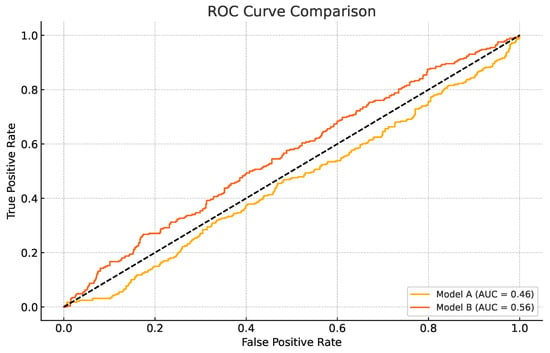
Figure 1
Open AccessArticle
Technological Heterogeneity in a Monetary Search Model and U.S. Money Demand
by
Yuchen Su
J. Risk Financial Manag. 2025, 18(11), 614; https://doi.org/10.3390/jrfm18110614 - 4 Nov 2025
Abstract
In this study, we incorporate heterogeneity in technology into a micro-founded monetary search framework to explain the recent trend in observed money demand, assuming technological heterogeneity so as to formalize the rise in high-tech innovations in the U.S. business sector that occurred in
[...] Read more.
In this study, we incorporate heterogeneity in technology into a micro-founded monetary search framework to explain the recent trend in observed money demand, assuming technological heterogeneity so as to formalize the rise in high-tech innovations in the U.S. business sector that occurred in the second half of the 1990s. The results show that this incorporation of technological heterogeneity allows the model to better fit the dynamics of the U.S. money demand curve.
Full article
(This article belongs to the Section Economics and Finance)
►▼
Show Figures

Figure 1
Open AccessArticle
Split-Screen Approach to Financial Modeling in Sustainable Fleet Management
by
Carlo Alberto Magni, Giomaria Columbu, Davide Baschieri and Manuel Iori
J. Risk Financial Manag. 2025, 18(11), 613; https://doi.org/10.3390/jrfm18110613 - 4 Nov 2025
Abstract
Large-scale transitions to eco-friendly vehicle fleets present complex capital budgeting challenges, requiring the integration of extensive operational data with financial modeling while balancing economic profitability and environmental sustainability. Traditional approaches often struggle to manage this complexity and quantify the inherent trade-offs. This study
[...] Read more.
Large-scale transitions to eco-friendly vehicle fleets present complex capital budgeting challenges, requiring the integration of extensive operational data with financial modeling while balancing economic profitability and environmental sustainability. Traditional approaches often struggle to manage this complexity and quantify the inherent trade-offs. This study develops and applies an innovative integrated accounting-and-finance framework to evaluate the economic and environmental implications of green fleet transition projects, explicitly quantifying the trade-off between profitability and sustainability. Focusing on waste vehicle replacement of Iren Spa, a leading European multi-utility company, we employ the recently developed Split-Screen Approach, a unified accounting-and-finance framework grounded in the laws of motion and conservation. It automatically reconciles pro forma financial statements and generates internally consistent valuation metrics, eliminating the manual adjustments and inconsistencies of traditional models. Its built-in diagnostic checks and scalability for highly complex datasets overcome the manual adjustments and inconsistencies inherent in traditional financial models. We process 2303 inputs across multiple “green” scenarios. This methodology integrates an Engineering Model, describing fleet evolution, operating costs, and CO2 reduction, with a HookUp Model, which serves to transform scenarios into well-defined projects. The latter model is then integrated with a Financial Model that generates pro forma financial statements, incorporates financing and payout policies, and assesses economic profitability through Net Present Value (NPV) and consistent accounting rates of return. Together, these elements form a robust framework for managing complex data integration and analysis. Our research reveals a fundamental trade-off: enhanced environmental sustainability (measured by Net Green Value, NGV), which quantifies CO2 reduction, is achieved at the expense of economic profitability, measured by NPV. This financial sacrifice is captured by the Net Value Curve, a Pareto frontier, while the NPV-to-NGV ratio provides “shadow prices” for CO2 reduction, revealing the financial cost per unit of sustainability gained. Based on 21 project scenarios and additional sensitivity analyses on financial inputs and energy prices, the results confirm a decreasing relationship between NGV and NPV. This study makes three main contributions: (1) it demonstrates the practical application of the Split- Screen Approach for capital budgeting under complexity, (2) it introduces the Net Value Curve framework as a useful tool for visualizing and quantifying the trade-off between profitability and sustainability, (3) it provides managers and policymakers actionable insights, supporting more informed decisions in green fleet transition planning where economic and environmental objectives may conflict. The findings provide managers and policymakers with a rigorous and transparent accounting-and-finance framework that enhances the reliability of capital budgeting decisions compared with traditional financial modeling, while offering a Paretian frontier for evaluating environmental trade-offs.
Full article
(This article belongs to the Special Issue Business, Finance, and Economic Development)
►▼
Show Figures

Figure 1
Open AccessSystematic Review
A Systematic Review of Artificial Intelligence Applied to Compliance: Fraud Detection in Cryptocurrency Transactions
by
Leslie Rodríguez Valencia, Maicol Jesús Ochoa Arellano, Santos Andrés Gutiérrez Figueroa, Carlos Mur Nuño, Borja Monsalve Piqueras, Ana del Valle Corrales Paredes, Sergio Bemposta Rosende, José Manuel López López, Enrique Puertas Sanz and Asaf Levi Alfaroviz
J. Risk Financial Manag. 2025, 18(11), 612; https://doi.org/10.3390/jrfm18110612 - 30 Oct 2025
Abstract
Rising financial fraud impacts industries, economies, and consumers, creating a need for advanced technological solutions. Compliance frameworks help detect and prevent illicit activities like money laundering, market manipulation, etc. However, with the rise of cryptocurrencies and blockchain, traditional detection methods are ineffective. As
[...] Read more.
Rising financial fraud impacts industries, economies, and consumers, creating a need for advanced technological solutions. Compliance frameworks help detect and prevent illicit activities like money laundering, market manipulation, etc. However, with the rise of cryptocurrencies and blockchain, traditional detection methods are ineffective. As a result, Artificial Intelligence (AI) has emerged as a vital tool for combating fraud in the cryptocurrency sector. This systematic review examines the integration of AI in compliance for cryptocurrency fraud detection between 2014 and 2025, analyzing its evolution, methodologies, and emerging trends. Using RStudio (Biblioshiny) and VOSviewer, 353 peer-reviewed studies from leading databases including SciSpace, Elicit, Google Scholar, ScienceDirect, Scopus, and Web of Science were analyzed following the PRISMA methodology. Key trends include the adoption of machine learning, deep learning, natural language processing, and generative AI technologies to improve efficiency and innovation in fraud detection. However, challenges persist, including limited transparency in AI models, regulatory fragmentation, and limited access to quality data, all of which hinder effective fraud detection. The long-term real-world effectiveness of AI tools remains underexplored. This review highlights the trajectory of AI in compliance, identifies areas for further research, and emphasizes bridging theory and practice to strengthen fraud detection in cryptocurrency transactions.
Full article
(This article belongs to the Section Financial Technology and Innovation)
►▼
Show Figures

Figure 1
Open AccessArticle
Assessing Fiscal Risk: Hidden Structures of Illicit Tobacco Trade Across the European Union
by
Evgenia Anastasiou, George Theodossiou, Andreas Koutoupis, Stella Manika and Konstantinos Karalidis
J. Risk Financial Manag. 2025, 18(11), 611; https://doi.org/10.3390/jrfm18110611 - 30 Oct 2025
Abstract
This paper investigates the risk determinants and spatial patterns of tax revenue loss due to illicit tobacco consumption across the 27 EU Member States from 2017 to 2022. Using a panel dataset covering economic, demographic, social, political, and behavioral dimensions, we apply principal
[...] Read more.
This paper investigates the risk determinants and spatial patterns of tax revenue loss due to illicit tobacco consumption across the 27 EU Member States from 2017 to 2022. Using a panel dataset covering economic, demographic, social, political, and behavioral dimensions, we apply principal component analysis to identify key factors associated with revenue loss, and hierarchical clustering to group countries with similar risk profiles. Geographic Information Systems visualize the spatial heterogeneity of fiscal vulnerabilities. Findings reveal that institutional and economic stability, international trade and market share, socio-economic inequality and tax burdens, health and well-being, demographic aging and social dynamics, tobacco taxation policy, and labor dynamics and shadow consumption structure the patterns of tax loss risk. Findings also highlight significant differences among Member States, emphasizing the multidimensional nature of fiscal risks.
Full article
(This article belongs to the Section Economics and Finance)
►▼
Show Figures

Figure 1
Open AccessTechnical Note
From Penalties to Protection: The Continuous Time Sustainable Efficiency Frontier
by
Lukas Müller
J. Risk Financial Manag. 2025, 18(11), 610; https://doi.org/10.3390/jrfm18110610 - 30 Oct 2025
Abstract
We develop a robust continuous time portfolio optimization framework that incorporates time-varying ESG risk through dynamically evolving drift ambiguity. Building on the equivalence between linear ESG penalties in mean-variance optimization and robust formulations under drift uncertainty, we extend the analysis to a dynamic
[...] Read more.
We develop a robust continuous time portfolio optimization framework that incorporates time-varying ESG risk through dynamically evolving drift ambiguity. Building on the equivalence between linear ESG penalties in mean-variance optimization and robust formulations under drift uncertainty, we extend the analysis to a dynamic setting with time-dependent, ESG-weighted ellipsoidal ambiguity sets. The model admits a tractable solution under CRRA preferences: the worst-case drift is obtained in closed form, and the optimal portfolio strategy is characterized as the unique maximizer of an ESG-adjusted Markowitz-type objective at each point in time. Economically, the framework provides a rigorous justification for penalty-based ESG portfolio models, while offering time-consistent robustness, forward-looking risk management, and dynamic hedging against sustainability-related model risk.
Full article
(This article belongs to the Special Issue Featured Papers in Mathematics and Finance, 2nd Edition)
Open AccessArticle
The Influence of Managerial Risk-Taking and Corporate Leadership on Firm Sustainability
by
Steve Swidler
J. Risk Financial Manag. 2025, 18(11), 609; https://doi.org/10.3390/jrfm18110609 - 30 Oct 2025
Abstract
This study examines whether CEO risk tolerance influences a firm’s sustainable practices, as measured by Environmental, Social, and Governance (ESG) scores. The analysis uses facial width–height ratio (fWHR) as a proxy for CEO testosterone and risk-taking behavior. A regression analysis of S&P 500
[...] Read more.
This study examines whether CEO risk tolerance influences a firm’s sustainable practices, as measured by Environmental, Social, and Governance (ESG) scores. The analysis uses facial width–height ratio (fWHR) as a proxy for CEO testosterone and risk-taking behavior. A regression analysis of S&P 500 firms from 2018 to 2022 shows that a greater fWHR is negatively associated with ESG scores, although the economic effect is small. A one standard deviation increase in fWHR decreases ESG by half a point on a 100-point scale. Further investigation into CEO turnover reveals a surprising asymmetry: when a new CEO has a higher fWHR, ESG scores increase significantly compared to firms without a CEO change. This finding, along with other confounding effects, suggests that a certain amount of calculated, strategic risk-taking may be necessary to successfully promote corporate sustainability programs.
Full article
(This article belongs to the Special Issue Corporate Finance: Financial Management of the Firm)
►▼
Show Figures

Figure 1
Open AccessArticle
Are Cryptocurrency Prices in Line with Fundamental Assets?
by
Melanie Cao and Andy Hou
J. Risk Financial Manag. 2025, 18(11), 608; https://doi.org/10.3390/jrfm18110608 - 30 Oct 2025
Abstract
This paper presents the first rigorous empirical investigation into a fundamental question of cryptocurrency valuation: Are cryptocurrency prices in line with the prices of fundamental assets? To answer this, we analyze the nine largest cryptocurrencies by market capitalization—Bitcoin (BTC), Ethereum (ETH), Solana (SOL),
[...] Read more.
This paper presents the first rigorous empirical investigation into a fundamental question of cryptocurrency valuation: Are cryptocurrency prices in line with the prices of fundamental assets? To answer this, we analyze the nine largest cryptocurrencies by market capitalization—Bitcoin (BTC), Ethereum (ETH), Solana (SOL), Binance Coin (BNB), Ripple (XRP), Cardano (ADA), Litecoin (LTC), Tron (TRX), and the stablecoin DAI—against a suite of traditional benchmarks, including major fiat currencies (EUR, CAD, JPY), gold, and the S&P500 index. Our dataset spans from 1 January 2014 to 30 June 2025, with start dates varying for newer cryptocurrencies to ensure robust time series analysis. Guided by the asset pricing theory, we formulate a martingale test: if a cryptocurrency is priced in line with a fundamental numeraire asset, its price ratio relative to that numeraire must follow a martingale process. Our extensive empirical analysis reveals that the prices of major cryptocurrencies (BTC, ETH, SOL, BNB) consistently reject the martingale hypothesis when traditional assets (currencies, gold, equities) serve as the numeraire, indicating a decoupling from fundamental valuation anchors. Conversely, when Bitcoin or Ethereum itself is used as the numeraire, most smaller cryptocurrencies are priced in line with these crypto benchmarks, suggesting an internal valuation ecosystem that operates independently of traditional finance.
Full article
(This article belongs to the Special Issue The Future of Money: Central Bank Digital Currencies, Cryptocurrencies and Stablecoins, 2nd Edition)
Open AccessArticle
Financial Literacy as a Catalyst for Women’s Economic Empowerment in the MENA Region: Evidence from a Structural Equation Model
by
Jeanne Laure Mawad, Nourhan El-Bayaa and Madonna Salameh-Ayanian
J. Risk Financial Manag. 2025, 18(11), 607; https://doi.org/10.3390/jrfm18110607 - 29 Oct 2025
Abstract
This study examines the role of financial literacy as a catalyst for women’s economic empowerment in the MENA region, focusing on its impact on financial performance through the mediating effects of autonomy and family support, as well as the moderating effects of male
[...] Read more.
This study examines the role of financial literacy as a catalyst for women’s economic empowerment in the MENA region, focusing on its impact on financial performance through the mediating effects of autonomy and family support, as well as the moderating effects of male partners and employment type. Drawing on data from 515 women professionals across five MENA countries, the research employs Partial Least Squares Structural Equation Modeling (PLS-SEM) to examine both direct and indirect relationships among key variables. The findings reveal that financial literacy significantly enhances financial performance, primarily by fostering greater autonomy in financial decision-making. While parental and spousal support also contribute, their mediating effects are comparatively weaker. Moreover, the relationship between financial literacy and autonomy is moderated by employment type and the presence of male partners, with employed women and those in collaborative environments experiencing stronger gains in autonomy. These results underscore the importance of targeted financial education and autonomy-enhancing policies to support women’s economic advancement in culturally complex and economically volatile contexts. The study contributes to the literature on gender and development economics by offering empirical evidence from an under-researched region and provides actionable insights for policymakers, educators, and organizations aiming to promote inclusive economic growth.
Full article
(This article belongs to the Special Issue Behaviour in Financial Decision-Making)
►▼
Show Figures

Figure 1
Open AccessArticle
Exploring the Link Between Financial Health Indicators: Insights from Perception, Lived Experiences and Financial Resilience: A Study on Employees of a Sugar Mill Company
by
Esmeralda Tejada-Peña, Arturo García-Santillán and Belem Alejandra Contreras-Rodríguez
J. Risk Financial Manag. 2025, 18(11), 606; https://doi.org/10.3390/jrfm18110606 - 29 Oct 2025
Abstract
The purpose of this study was to assess workers’ perceptions, experiences, and strategies related to financial health, with the goal of identifying and validating a model of financial resilience aligned with theoretical and empirical fit criteria. A sequential quantitative approach was employed, combining
[...] Read more.
The purpose of this study was to assess workers’ perceptions, experiences, and strategies related to financial health, with the goal of identifying and validating a model of financial resilience aligned with theoretical and empirical fit criteria. A sequential quantitative approach was employed, combining exploratory factor analysis (EFA) to uncover latent dimensions, followed by confirmatory factor analysis (CFA) to validate the resulting structure. This dual methodology was designed to ensure both empirical robustness and theoretical coherence. The study used a non-experimental, cross-sectional design and drew on survey data from 311 employees of a sugar company in San Juan Bautista Tuxtepec, Oaxaca, selected through a non-probabilistic self-selection sampling method. The instrument, based on existing models was administered electronically. Internal consistency was assessed using Cronbach’s alpha (α), McDonald’s omega (ω), composite reliability (CR), and average variance extracted (AVE), while multivariate normality was also examined. Findings reveal that financial resilience encompasses not only recovery from financial shocks but also proactive financial behaviors such as budgeting, long-term saving, and responsible debt management. Respondents emphasized the role of credit history, insurance access, and perceived financial autonomy in promoting both financial stability and emotional well-being. These results contribute to the theoretical conceptualization of financial resilience and have practical implications for policy and financial education with a preventive and mental health-oriented perspective.
Full article
(This article belongs to the Section Economics and Finance)
►▼
Show Figures

Figure 1
Open AccessArticle
Using Machine Learning to Detect Financial Statement Fraud: A Cross-Country Analysis Applied to Wirecard AG
by
Luca Steingen and Edgar Löw
J. Risk Financial Manag. 2025, 18(11), 605; https://doi.org/10.3390/jrfm18110605 - 28 Oct 2025
Abstract
This study analyzes the ability of machine-learning algorithms to detect financial statement fraud using four financial ratios as inputs: the Altman Z-Score, Beneish M-Score, Montier C-Score, and Dechow F-Score. It also evaluates whether the Wirecard AG scandal of 2020 could have been detected
[...] Read more.
This study analyzes the ability of machine-learning algorithms to detect financial statement fraud using four financial ratios as inputs: the Altman Z-Score, Beneish M-Score, Montier C-Score, and Dechow F-Score. It also evaluates whether the Wirecard AG scandal of 2020 could have been detected by the model developed in this study. Financial statement data was obtained from the financial data vendor Bloomberg L.P. The dataset consists of 2,014,827 firm years between 1988–2019, from companies across the globe, of which 1145 firm years were identified as fraudulent. A balanced dataset of 1046 fraudulent firm years and 1046 randomly selected firm years was used to train and evaluate multiple machine-learning algorithms via an automated pipeline search. The selected model is an ensemble combining gradient boosting and k-nearest neighbors. On the held-out test set, it correctly classified 82.03% of the manipulated and 89.88% of the non-manipulated firm years, with an overall accuracy of 85.69%. Applied retrospectively to Wirecard AG, the model identified 7 of 17 firm years as fraudulent.
Full article
(This article belongs to the Special Issue AI and Emerging Technologies in Governance, Risk and Earnings Management)
►▼
Show Figures
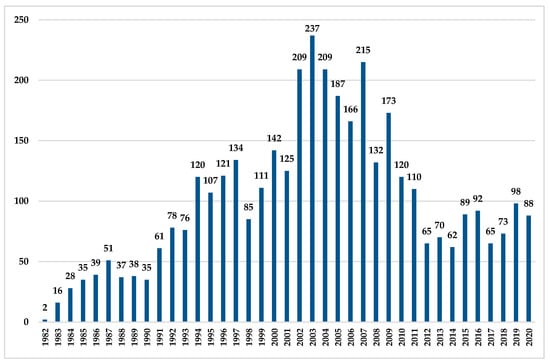
Figure 1
Open AccessArticle
Balancing Shariah Authenticity and Market Stability: A Scenario-Based Framework for Implementing AAOIFI Shariah Standard No. 62 in the Global Sukuk Market
by
Tasawar Nawaz
J. Risk Financial Manag. 2025, 18(11), 604; https://doi.org/10.3390/jrfm18110604 - 28 Oct 2025
Abstract
This work develops a scenario-based policy framework for the prospective implementation of AAOIFI Shariah Standard No. 62 in global sukuk markets. The analysis suggests that immediate, rigorous enforcement would advance Shariah authenticity yet risk near-term destabilisation: issuance could retrench, the pricing premia could
[...] Read more.
This work develops a scenario-based policy framework for the prospective implementation of AAOIFI Shariah Standard No. 62 in global sukuk markets. The analysis suggests that immediate, rigorous enforcement would advance Shariah authenticity yet risk near-term destabilisation: issuance could retrench, the pricing premia could widen, and the rating treatment could bifurcate or even become inapplicable for instruments with pronounced risk-sharing. By contrast, calibrated sequencing, targeted legal reforms to perfect title transfer, and harmonised supervisory guidance can mitigate fragmentation and sustain investor confidence while re-anchoring sukuk to their risk-sharing foundations. Taken together, aligning religious fidelity with market pragmatism is achievable: a measured adoption of Standard 62 can reinforce the ethical underpinnings of Islamic capital markets without compromising their capacity for resilient growth.
Full article
(This article belongs to the Section Economics and Finance)
►▼
Show Figures
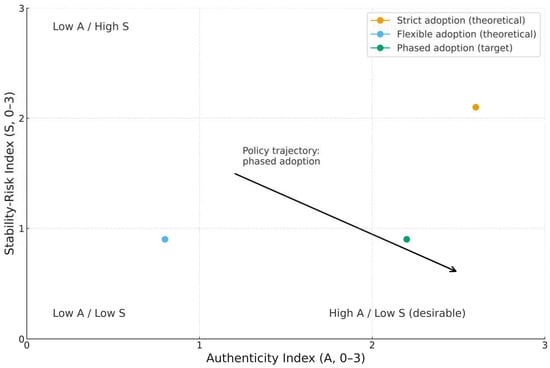
Figure 1
Open AccessArticle
Financing Rural Futures: Governance and Contextual Challenges of Village Fund Management in Underdeveloped Regions
by
Ari Warokka, Vetaroy Warokka and Aina Zatil Aqmar
J. Risk Financial Manag. 2025, 18(11), 603; https://doi.org/10.3390/jrfm18110603 - 28 Oct 2025
Abstract
Effective management of village funds is central to financing sustainable and equitable rural futures, particularly in underdeveloped and resource-diverse regions such as Papua, Indonesia. This study explores the governance factors that shape the sustainability of village fund management (VFM) by examining institutional, financial,
[...] Read more.
Effective management of village funds is central to financing sustainable and equitable rural futures, particularly in underdeveloped and resource-diverse regions such as Papua, Indonesia. This study explores the governance factors that shape the sustainability of village fund management (VFM) by examining institutional, financial, and socio-cultural dimensions across 212 villages. Primary data from village heads and secondary data on village-owned enterprises (BUMDes) and 2024 village fund allocations were analyzed using exploratory factor analysis (EFA), partial least squares structural equation modeling (PLS-SEM), and multi-group analysis (MGA). Seven key governance constructs emerged, with ethical governance, implementation capacity, mandatory disclosure and reporting, community participation, and financial management capacity demonstrating significant positive effects on sustainable VFM outcomes. In contrast, perceived social and economic impacts were negatively associated with performance, and planning quality exerted an influence only under specific contextual conditions. These relationships proved highly context-dependent, varying by geography, natural resource availability, transport accessibility, and demographic composition. The findings underscore the need for adaptive and context-sensitive governance strategies to strengthen institutional resilience, enhance fiscal equity, and maximize the developmental impact of village funds in underdeveloped rural regions.
Full article
(This article belongs to the Section Applied Economics and Finance)
►▼
Show Figures
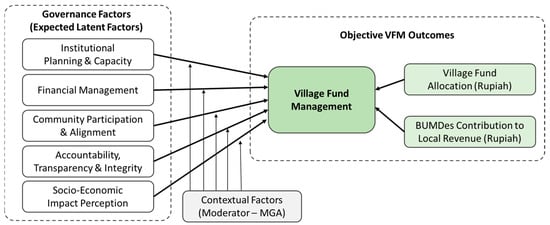
Figure 1
Open AccessArticle
The Influence of the Digital Accounting System on the Quality of Sustainable Decision-Making
by
Ahmed Almgrashi
J. Risk Financial Manag. 2025, 18(11), 602; https://doi.org/10.3390/jrfm18110602 - 28 Oct 2025
Abstract
This study assesses De Lone and McLean’s Information System (D&M IS) Success Model concerning DAS throughout small and medium enterprises (SMEs) in Saudi Arabia (SA). The present work mainly sought to evaluate the impact of information quality (IQ), system quality (SysQ), service quality
[...] Read more.
This study assesses De Lone and McLean’s Information System (D&M IS) Success Model concerning DAS throughout small and medium enterprises (SMEs) in Saudi Arabia (SA). The present work mainly sought to evaluate the impact of information quality (IQ), system quality (SysQ), service quality (SrvQ) serving, system utilization, and user satisfaction (Usat) on the usage of the Digital Accounting System (DAS), which is posited to ultimately improve the quality of sustainable decision-making. The research utilized a quantitative methodology, employing a self-administered questionnaire to collect data from 328 decision-makers who are knowledgeable about actual DAS usage by SMEs in SA. Subsequent to gathering data, validation was conducted via Structural Equation Modeling (SEM) by utilizing smart-PLS software. The findings indicate that SysQ and IQ significantly influenced system utilization, although SrvQ did not. DAS was determined to significantly influence user happiness. Moreover, system utilization and user satisfaction positively influenced DAS, thereby affecting the sustainability of decision-making and reflecting the overall benefits of DAS. This work enhances the current IS literature by identifying the characteristics that affect the net advantages of DAS, with the suggested model evaluated in SMEs in SA utilizing DAS. This study serves as a reference to elucidate the significance of DAS and offers consequences, limitations, and prospects for further research.
Full article
(This article belongs to the Section Business and Entrepreneurship)
►▼
Show Figures

Figure 1
Highly Accessed Articles
Latest Books
E-Mail Alert
News
Topics
Topic in
Clean Technol., Economies, FinTech, JRFM, Sustainability
Green Technology Innovation and Economic Growth
Topic Editors: David (Xuefeng) Shao, Miaomiao Tao, Selena ShengDeadline: 31 December 2025
Topic in
Economies, IJFS, JRFM, Risks, Sustainability
Insurance and Risk Management Advances in the 4A Era—AI, Aging, Abruptions, and Adoptions
Topic Editors: Xiaojun Shi, Lingyan Suo, Feng Gao, Baorui DuDeadline: 30 May 2026
Topic in
Economies, JRFM, Risks, Sustainability
The Future of Global Finance and Business: Trends, Policies and Market Evolution
Topic Editors: John Malindretos, Giuliana Andreopoulos, Ikechukwu Ndu, Eleftherios I. ThalassinosDeadline: 31 July 2026
Topic in
Economies, IJFS, Sustainability, Businesses, JRFM
Sustainable and Green Finance
Topic Editors: Otilia Manta, Maria PalazzoDeadline: 31 October 2026

Conferences
Special Issues
Special Issue in
JRFM
Earnings Management and Loan Contracts
Guest Editor: Peter DemerjianDeadline: 30 November 2025
Special Issue in
JRFM
Banking Practices, Climate Risk and Financial Stability
Guest Editors: Stefano Zedda, Dario Salerno, Helen ChiappiniDeadline: 30 November 2025
Special Issue in
JRFM
Featured Papers in Climate Finance
Guest Editors: Christopher Gan, Linh HoDeadline: 30 November 2025
Special Issue in
JRFM
Lending, Credit Risk and Financial Management
Guest Editor: Xiaolu HuDeadline: 30 November 2025
Topical Collections
Topical Collection in
JRFM
Quantitative Advances and Risks in Asian Financial Markets
Collection Editors: Svetlozar (Zari) Rachev, Shigeyuki Hamori, Yasushi Hamao, Shuangzhe Liu, Ali Jaffri




